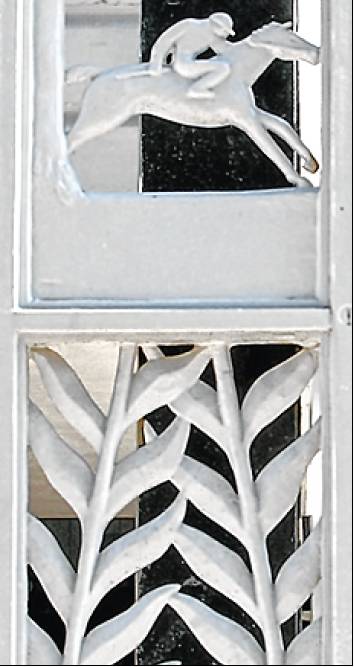| New season begins at historic Saratoga track, ‘love affair’ intact Teresa A. Genaro TAG AT THE TRACK
More than a decade ago, I was asked to write about the sometimes-uneasy relationship between tradition and modernization at Saratoga Race Course. Back then, some of the features that we now consider rather unremarkable mainstays were brand-new and not without controversy. The Post Bar and Shake Shack had been recently established, and while the former, which underwent a complete renovation and upgrade last year, was immediately embraced by racing enthusiasts (though the new version was roundly criticized last year), the sleek, metal-forward Shake Shack was derided as an affront to the track’s aesthetic. The 1863 Club, The Stretch hospitality area at the eastern end of the grandstand, and the resurrection of the Wilson Chute were also both celebrated and bemoaned when they débuted (and lest you think that I’m casting aspersions on the critics, I am not infrequently among those greeting with skepticism any changes to my hometown track). Growing up in Saratoga in the 1980s, I would not have considered myself a big racing fan, despite a number of family ties to the sport. My mother worked at the National Museum of Racing and Hall of Fame for a number of years, serving briefly as its director; my parents owned harness horses for much of my childhood; both my brother and I worked at Fasig-Tipton during the sales. I went to the track occasionally in high school and college, and when I left Saratoga first for graduate school and then for a teaching career, all far from upstate New York, I pretty much stopped paying attention to the sport. For years, I couldn’t have told you who won the Kentucky Derby. Shortly after the turn of the last century, my interest reignited, thanks in part to Afleet Alex, whose two-year-old races here, especially his erratic, green, veering win in the Hopeful, charmed me and instigated the first time I followed a horse all year round, outside of New York. The other trigger was a detail in the ornate white iron railings, railings past which I’d walked hundreds of times but in 2007 arrested me, quite literally stopping me in my tracks. “Founded 1864” I remember thinking, 1864? My English-teacher brain immediately went to Charles Dickens and Anthony Trollope, George Eliot and Elizabeth Gaskell. I thought of “Uncle Tom’s Cabin” and Nathaniel Hawthorne and the Battle of Gettysburg. I had rarely, if ever, before thought of any of those things as contemporaneous with the racetrack in my hometown, certainly not the British novels that I loved. I dove into newspaper archives, finding that the digital New York Times dates to 1851 and thus carried daily coverage of the four-day 1864 meet — the first at the track on its current site. I was engrossed by the track’s cultural, social, economic, and political significance, and I started blogging about racing history in New York, an endeavor that led to being credentialed for the 2008 Saratoga meet, which in turn led to my first paid-freelance gig, writing for The Pink Sheet in 2009. For Christmas 2009, my mother compiled a scrapbook of every story I wrote that summer, a remarkable gift that is a treasured artifact of my first bylines, especially meaningful because they were on stories in my hometown paper about my hometown track. Fourteen years later, I’m not quite as wide-eyed with wonder as I was back then. Horse racing is too troubled for me to embrace it as fully as I did then, but my awe of the longevity and history of Saratoga Race Course is undiminished, particularly in the context of thoroughbred racing in New York state. The Belmont Park that so many of us have known since the 1960s will shortly cease to exist, and its grand reopening in its next incarnation will start the final death toll for Aqueduct Racetrack. Saratoga predates both of those tracks — Belmont opened in 1905, Aqueduct in 1894 — and it is the only of the three still recognizable from its inception. Both Belmont and Aqueduct underwent major renovations in the 1950s and 1960s, and as Paul Roberts and Isabelle Taylor suggested in their excellent 2017 book, “The Spa: Saratoga’s Legendary Race Course,” Saratoga’s very remoteness, in those days before interstate highways, is likely what saved it. As the physical landscape of New York racing is about to change dramatically, Saratoga is comfortingly, achingly familiar and recognizable, even to those who started watching races there generations before I did. In that 2011 story about Saratoga’s changes, I wrote about coming back to the track after a long time away: “But in the summer of 2000, I came back. Licking the wounds of an unexpected summer breakup that had thrown a wrench into August vacation plans, I joined my brother and some friends on their annual ‘Run for the Tables’ on Travers morning. And in one afternoon under the trees, accompanied by a cadre of long-time Saratoga friends, a cooler of beer, sandwiches, and a daylong show parlay, the broken love affair was replaced by one far sturdier.” A dozen years later, that relationship has been tested, by scandal, by tragedy, by inept and irresponsible leadership, by illness. Yet nearly a quarter of a century after that reunion under the trees, it remains intact. Happy opening day, and here’s to many more.
TERESA A. GENARO An ornate white iron railing is shown at Saratoga Race Course in Saratoga Springs.
| |



